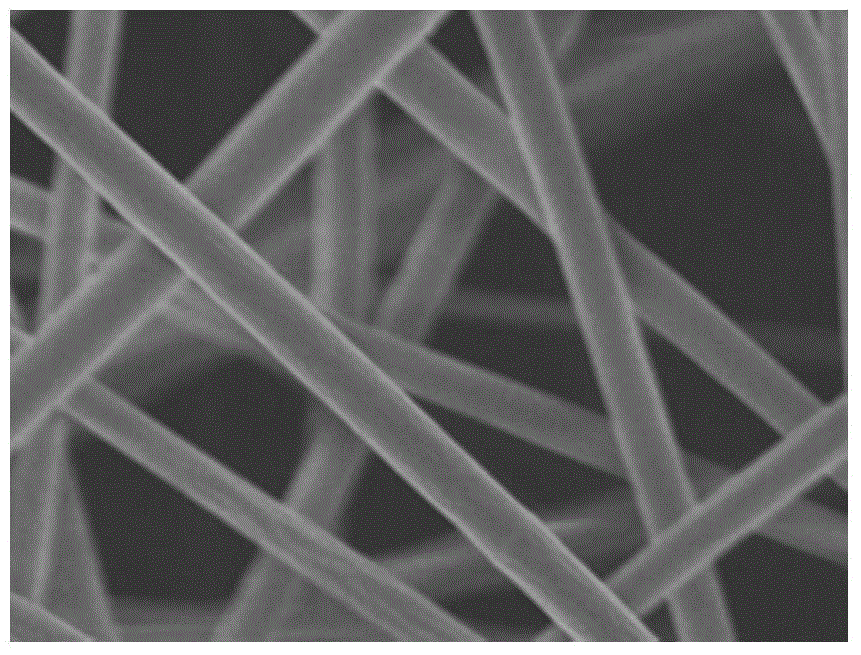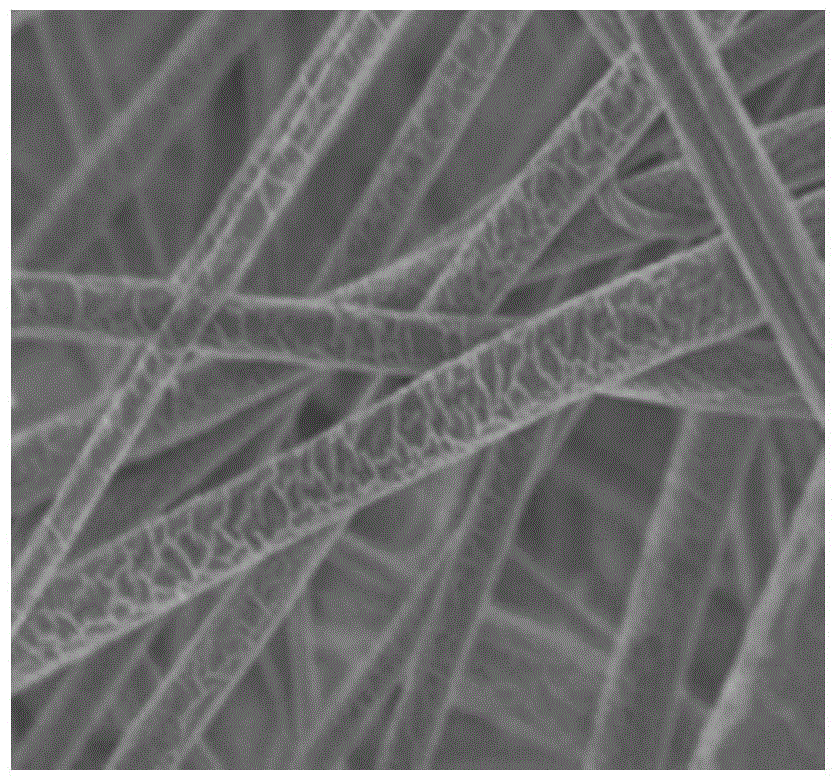Preparation method of conductive graphene nanofiber membrane
A nanofiber membrane, conductive nanotechnology, applied in fiber processing, textiles and papermaking, non-woven fabrics, etc., can solve the problems of small preparation scale, poor biocompatibility, limited application of nanomaterials, etc., to overcome biocompatibility Effects of sexual influence, mild reaction conditions, and simple production process
- Summary
- Abstract
- Description
- Claims
- Application Information
AI Technical Summary
Problems solved by technology
Method used
Image
Examples
Embodiment 1
[0030] Example 1 Using polyvinyl chloride as raw material to make graphene conductive nanofiber membrane
[0031] (1) Dissolve 0.2 g of polyvinyl chloride in a mixture of tetrahydrofuran and N,N dimethylformamide with a volume ratio of 8:2 to prepare a spinning solution, and the mass fraction of the spinning material in the total system is 1%. , and under magnetic stirring until the solution was clear and homogeneous, then centrifuged at 1000 rpm for 5 minutes to remove air bubbles in the solution.
[0032] (2) Electrospinning is carried out in a self-made electrospinning device. Electrospinning parameters: the inner diameter of the spinneret is 0.22mm, the receiving distance is 10cm at a voltage of 15KV, and the electrospinning is carried out at a propulsion speed of 1.0mL / h. The fibers were spun onto filter paper, and the volume of each fiber membrane spinning solution was 1.0 mL. The collected electrospun nanofiber membranes were dried under vacuum at room temperature for ...
Embodiment 2
[0036] Example 2 Using polyacrylonitrile as raw material to make graphene conductive nanofiber membrane
[0037] (1) Dissolve 0.85 g of polyacrylonitrile in a mixture of tetrahydrofuran and N,N dimethylformamide with a volume ratio of 6:2 to prepare a spinning solution, and the mass fraction of the spinning material in the total system is 5%. , and under magnetic stirring until the solution was clear and homogeneous, then centrifuged at 1000 rpm for 5 minutes to remove air bubbles in the solution.
[0038] (2) Conduct electrospinning in a homemade electrospinning device, electrospinning parameters: the inner diameter of the spinneret is 0.22mm, the receiving distance is 10cm at a voltage of 12KV, and the electrospinning is carried out at a propulsion speed of 0.8mL / h. The fibers were spun onto filter paper, and the volume of each fiber membrane spinning solution was 1.0 mL. The collected electrospun membranes were vacuum-dried at room temperature for 24 hours for later use. ...
Embodiment 3
[0042] Example 3 Using polylactic acid-glycolic acid copolymer as raw material to make graphene conductive nanofiber membrane
[0043] (1) Dissolving 1.35 grams of polylactic acid-glycolic acid copolymer in a mixture of tetrahydrofuran (THF) and N,N dimethylformamide (DMF) with a volume ratio of 4:2 is configured as a spinning solution, and spinning The mass fraction of the material in the total system is 10%, and the solution is clarified and homogeneous under magnetic stirring, and then centrifuged at 1000 rpm for 5 minutes to remove air bubbles in the solution.
[0044] (2) Electrospinning is carried out in a self-made electrospinning device. Electrospinning parameters: the inner diameter of the spinneret is 0.22mm, the receiving distance is 10cm under the voltage of 10KV, and the electrospinning is carried out at a propulsion speed of 0.5mL / h. The fibers were spun onto filter paper, and the volume of each fiber membrane spinning solution was 1.0 mL. The collected electros...
PUM
| Property | Measurement | Unit |
|---|---|---|
| concentration | aaaaa | aaaaa |
| diameter | aaaaa | aaaaa |
Abstract
Description
Claims
Application Information
 Login to View More
Login to View More - R&D
- Intellectual Property
- Life Sciences
- Materials
- Tech Scout
- Unparalleled Data Quality
- Higher Quality Content
- 60% Fewer Hallucinations
Browse by: Latest US Patents, China's latest patents, Technical Efficacy Thesaurus, Application Domain, Technology Topic, Popular Technical Reports.
© 2025 PatSnap. All rights reserved.Legal|Privacy policy|Modern Slavery Act Transparency Statement|Sitemap|About US| Contact US: help@patsnap.com



